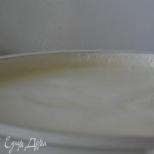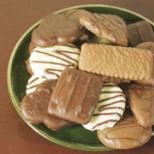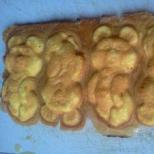Successful AIRFIX models.
High-explosive pressure anti-personnel mine. Designed to disable enemy personnel. The defeat of a person is inflicted due to the destruction of the lower part of the leg (foot) during the explosion of the mine charge at the moment the foot steps on the pressure cover of the mine. Usually, when a mine explodes, the foot of the foot with which the enemy soldier stepped on the mine is completely torn off, and, depending on the distance, the second leg from the explosion site, it can also be significantly damaged or not be damaged at all. In addition, a shock wave of a sufficiently large explosive charge deprives a person of consciousness, the high temperature of explosive gases can cause significant burns. lower limbs. Death can come from pain shock, blood loss due to untimely first aid.
The mine can be installed both on the ground and in the ground, in the snow, manually or laid out by means of mechanization (trailed mine spreaders PMR-1, PMR-2, but in all cases the transfer of the mine to the combat position is carried out manually.
The service life of the mine is limited by the service life of the wooden hull. If it is destroyed by decay, the pressure cover may not squeeze the combat pin out of the fuse and the explosion will not occur. The mine is not equipped with a self-liquidator. It does not have elements of non-removability and non-decontamination, however, the very high sensitivity of the MUV series fuse makes deactivation of the mine extremely dangerous. In addition, a surprise mine can be installed under a mine, which makes it impossible to remove or defuse the mine.
The mine consists of a wooden case, TNT 200gr. TNT bomb, fuse series MUV with "T"-shaped pin, fuse MD-2 (MD-5M)
Tactical and technical characteristics of mines
Type of mine……………………………………………….
Case……………………………………........ wood.
Hull weight (without explosives)………………………290g.
Mass of explosive (TNT)…..….200 gr.
Length……………………………....……...…..20 cm.
Width…………………………....……...…..9 cm.
Case height………………………….........5 cm.
Target sensor dimensions (pressure cover)....20x9cm..
Sensitivity…………………………...6 - 28 kg.
Temperature range of application…..-60 --+60 degrees.
The degree of safety of mine installation depends on the type of fuse series MUV. For example, when using fuses MUV-2, MUV-3, from the moment the safety pin is pulled out to the moment the fuse is cocked, depending on the ambient temperature, it takes from 3 min. (at +40 degrees) up to 59 hours (at -40 degrees).
Mines are packed in boxes of 100 pcs. (gross weight 63 kg.) not fully equipped (body and checker).
 The older version of the mine under the PMD-6 index differs from the PMD-6M in that there was no leaf spring on the underside of the cover (indicated by the number 5 in the figure), which increases the actuation force from 1-17 kg to 6 - 28 kg.
The older version of the mine under the PMD-6 index differs from the PMD-6M in that there was no leaf spring on the underside of the cover (indicated by the number 5 in the figure), which increases the actuation force from 1-17 kg to 6 - 28 kg.
At present, the PMD-6M mine is not produced, it is not listed in the supply tables of the troops, however, all its components, except for the wooden hull, are listed in the time sheets as mine-blasting property and are widely used in other mines, explosive business. And the production of wooden hulls can be organized in a matter of days or even hours directly in the engineer-sapper battalion .. Therefore, this mine has not been removed from the armament of the army.
Sources
1. Engineering ammunition. Guide to the material part and application. Book one. Military publishing house of the USSR Ministry of Defense. Moscow. 1976
2. B.V. Varenyshev et al. Textbook. Military engineering training. Military publishing house of the USSR Ministry of Defense. Moscow. 1982
---***---
From the author. Mina is surprisingly simple. A slit is made in the end side of the cover, clearly visible in the figure. When the lid is closed, its edges rest on the T-shaped combat pin of the MUV fuse. When an enemy soldier steps on a mine, the edges of the cover resting on the combat pin will squeeze the pin down and an explosion will occur.
Its predecessor, the PMD-6 mine, did not have a spring. The combat check of the MUV fuse pops up very easily, so easily that the installation of the PMD-6 mine was dangerous for the sapper himself. Before lowering the lid into place, it was necessary to put a nail on the body with a rope tied to it and pull it out from a safe distance, the lid fell into place and the mine came into combat position. There were frequent cases when in the spring, under a load of melting snow, the lid squeezed out the combat check and the mines exploded spontaneously.
This mine (PMD-6M) was never removed from service because these mines can be mass-produced, without any industrial base at all, directly in the troops.
However, minefields from these mines cannot be cleared at all. You can't say it's dangerous. Going to mine such a field is simply suicide.
Mi-2 helicopter models
Evgeny Borisov
The appearance on sale of the model from AMODEL allowed our modellers to easily get the "deuce" in their collection. When, according to the usual practice of our firms, the entire first issue went to foreign countries, I purchased either a defective or "left" copy from the MKSM. He was in idle plastic bag, stapled to the top of a black-framed cardboard box. The set was not supplied with decals, and the instruction was a simple, reduced to A5 format, copy of the instruction from AEROTEAM.
Another model that caught my eye a little later was also, in its own way, unique. Plastic and instructions from AEROTEAM, decals from AMODEL, and the AIREX PROMODEL logo on the box. Here is such a sandwich! No wonder the box says "limited edition". More details about this model.
There are 50 parts on a light gray plastic sprue and 11 transparent parts on another sprue. The inner lining is thin. Rivets are very small and neat. The surface of the fuselage is smooth, without shells and scratches. So, in my opinion, the model is most suitable for assembling civilian versions of the Mi-2 with a glossy or semi-gloss paintwork.
Yes, and weapons are still not included in the kit. I can’t say that this is a rule, but one of my foreign acquaintances purchased an AMODEL model without weapons. That is, it was simply not on the sprues. And in the instructions, the details of the weapons were crossed out.
 However, the Ukrainian model compares favorably with the number of details. I counted 132, including transparent ones. You can assemble a model of almost any modification. Jointing internal, without rivets.
However, the Ukrainian model compares favorably with the number of details. I counted 132, including transparent ones. You can assemble a model of almost any modification. Jointing internal, without rivets.  Molding quality is slightly worse, but not enough to speak of low quality. And yet, the main advantage of this model is its versatility - all versions in one box. And not only in the form of coloring and decals, but, precisely, in plastic.
Molding quality is slightly worse, but not enough to speak of low quality. And yet, the main advantage of this model is its versatility - all versions in one box. And not only in the form of coloring and decals, but, precisely, in plastic.
As reference material when assembling and painting Mi-2 models, I recommend using the ZLINEK magazine, a good half of which is devoted to the "two". In it you will find drawings, paint schemes and many high-quality black and white and color photographs.
MODEL
Successful AIRFIX models
Evgeny Borisov
 There are such twins from the AIRFIX-HELLER family: SA 341 and SA 342M Gazelle. Their only difference is that french model there are weapons and the upper glass is made together with the sighting system ...
There are such twins from the AIRFIX-HELLER family: SA 341 and SA 342M Gazelle. Their only difference is that french model there are weapons and the upper glass is made together with the sighting system ...
Now we will talk about SA 341 Gazelle [#01059]. 36 gray plastic parts, 6 glazing parts and 80x55 mm decal will allow you to assemble one of two versions: SA 341B AH.Mk.1 (212 units built) or SA 341D HT.Mk.3 (29 units built). Both helicopters are used as training helicopters.
 The alignment of the fuselage halves is good - there is no need to putty the seam. External stitching, worked out with high quality and no frills. The glazing is thin and transparent, with detailed frames. There are no complaints about the upper and nasal glass. But the side windows are smaller in size and thickness than openings. And with openings, and with glasses, you will have to work extra. The fenestron has very thick blades, but after processing them, it is possible to achieve rotation of the screw from a light breath. And most importantly: try, as much as possible (within reason), to make the bow heavier. Otherwise, the model will fall on its tail. I had to remove the already glued plastic dashboard and replace it with lead. Basically, that was enough. There are simply no other places suitable for this. The Gazelle model cannot be called so successful, rather uncontested. The beginning of the series "AIRFIX. No alternative." read in the next issue.
The alignment of the fuselage halves is good - there is no need to putty the seam. External stitching, worked out with high quality and no frills. The glazing is thin and transparent, with detailed frames. There are no complaints about the upper and nasal glass. But the side windows are smaller in size and thickness than openings. And with openings, and with glasses, you will have to work extra. The fenestron has very thick blades, but after processing them, it is possible to achieve rotation of the screw from a light breath. And most importantly: try, as much as possible (within reason), to make the bow heavier. Otherwise, the model will fall on its tail. I had to remove the already glued plastic dashboard and replace it with lead. Basically, that was enough. There are simply no other places suitable for this. The Gazelle model cannot be called so successful, rather uncontested. The beginning of the series "AIRFIX. No alternative." read in the next issue.
MODEL
MATCHBOX is not as scary as his...
Evgeny Borisov
Ending. Start in releases and Another model that may be of interest to collectors and modellers today is the AH-1G HueyCobra [#40009]. The very first serial modification combat helicopter Bell-209. 1127 units were built. Plus two AH-1G Snake helicopters used by the "Cobra Air Interception Team" of the US Customs Service. Instead of a bow weapon, a powerful searchlight of the "Nightsun" type was installed on it.
Another model that may be of interest to collectors and modellers today is the AH-1G HueyCobra [#40009]. The very first serial modification combat helicopter Bell-209. 1127 units were built. Plus two AH-1G Snake helicopters used by the "Cobra Air Interception Team" of the US Customs Service. Instead of a bow weapon, a powerful searchlight of the "Nightsun" type was installed on it.
 Mold model of a very respectable age: "MATCHBOX" LESNEY PROD.P.L.C. © 1973. The model's two sprues are molded from plastic in two colors: dark and light brown. There are only 42 parts on them. Glass was included separately. The decal is very poor (2 pairs of side numbers, 2 pairs of inscriptions, stripes for the fuselage and propeller blades) and hard. Personally, I used the inscriptions (I put them on the varnish), and applied the stripes with paint - the decal also has problems with glue. Jointing is combined: in the front part it is very deep internal, and on the tail boom it is barely noticeable, external. There is no detailing, but the seat cushions, belts, operator's instrument panel and antenna are easy to make. Hinges are marked on the main rotor hub, but they are connected to the blade butt with a thick (~0.8 mm) flat sprue. After removing which, the sleeve takes on a more elegant look. The glass is asymmetrical (on the left side it is more convex), but thick enough for polishing. As expected, the assembled model still has movable propellers and a bow machine gun. The main assembly recommendation, which is not mentioned in the instructions, is the weight in the bow. The tail of the model is quite heavy and, therefore, 3-5 grams of lead under the cabin floor will not be superfluous.
Mold model of a very respectable age: "MATCHBOX" LESNEY PROD.P.L.C. © 1973. The model's two sprues are molded from plastic in two colors: dark and light brown. There are only 42 parts on them. Glass was included separately. The decal is very poor (2 pairs of side numbers, 2 pairs of inscriptions, stripes for the fuselage and propeller blades) and hard. Personally, I used the inscriptions (I put them on the varnish), and applied the stripes with paint - the decal also has problems with glue. Jointing is combined: in the front part it is very deep internal, and on the tail boom it is barely noticeable, external. There is no detailing, but the seat cushions, belts, operator's instrument panel and antenna are easy to make. Hinges are marked on the main rotor hub, but they are connected to the blade butt with a thick (~0.8 mm) flat sprue. After removing which, the sleeve takes on a more elegant look. The glass is asymmetrical (on the left side it is more convex), but thick enough for polishing. As expected, the assembled model still has movable propellers and a bow machine gun. The main assembly recommendation, which is not mentioned in the instructions, is the weight in the bow. The tail of the model is quite heavy and, therefore, 3-5 grams of lead under the cabin floor will not be superfluous.
Finishing the conversation about MATCHBOX models, it should be noted that the remaining seven 1:72 scale helicopter models have, today, higher quality analogues produced by other companies.
thanks to: Pawel Okulski.
Sergey Shumilin / Kharkiv
I immediately admit that I do not know about copies of the Mi-2 in 1:144 scale, which is becoming increasingly popular, although I fully admit that they exist. There are enough model fanatics and modeling micro-firms in the world who, either in New Zealand or in the vast expanses of the United States, use “garage technology” (when all production equipment is placed in their own garage) to pour absolutely unimaginable rarities from epoxy and “white metal” .
About relatively large models, we can say that once. 30 years ago, there was such a children's toy "Mi-2 Helicopter" produced by the Moscow factory "Krugozor", made on a scale of approximately 1:50. Details of this "copy" were cast from plastic white color, there was a transparent cockpit canopy, and in the assembled state the model even resembled the Mi-2, but what else could you require from a set for children's creativity (as it was written on the box)? For desperate fans of the forty-eighth scale, we can add that this model has not been produced for a long time and it is almost impossible to get it, and it is not worth the effort - it is easier to cut the helicopter again.
On a scale of 1:72, Mi-2 models are produced by the following companies: Ukrainian A-model, Czech Ariex Pro Model / Aero and Polish Intech. In the same order, they appeared on the model market,
Mi-2 from A-model was the first sign. This model went on sale in 1EE7 and was one of the first products of this then very few people famous company. According to modeling aksakals, the "master" for this copy was developed in Odessa, which at that time often delighted us with model novelties (one can recall at least the Su-25 from Fakel), and the Kiev A-modei joined the project at a later stage.
As you know, A-model models are produced using the sort run technology, all the shortcomings of which - pour over, "floated" parts, etc. - do not need to be explained in detail. Since by now the molds of the model are already quite old, wear has also been added to all the initial “charms”. The kit allows you to build a model in several versions: peaceful Mi-2T and traffic cop, as well as combat Mi-2URP, URN and URP-G. Accordingly, the number of parts of the set is quite large - 134 pcs. For designing the model, 8 decal options are offered: German and Czech police, Soviet traffic police, Czech ambulance squadron, etc. Unfortunately, there were some mistakes. For example, the state registration number of the “GAI” variant is six-digit and starts with the number 24, although it should be five-digit and start with 14, 15, 20 or 23, and Mi-8 numbers began with 24.
As for the large parts of the kit, for example, the fuselage halves, they were initially quite neat, with thin internal paneling, without underfilling or shrinkage. Unfortunately, the same cannot be said for the finer details. Most modellers, having waved their hand at them, make little things (tail support › HPH, struts, antennas, etc.) on their own. This is easier than finishing overly rough stock castings. The glasses, which are quite a lot on the Mi-2, are uneven in the model, with some inclusions and, to put it mildly, opaque. There are two bushings on the sprues, and only one is indicated in the assembly instructions (obviously, it is proposed to ignore the second one). But., if the blades are glued to the bushing indicated in the instructions, again according to the instructions and in accordance with the seats, then the rotation of the rotor will turn out to be opposite to natural. The sleeve not indicated in the instructions does not have this error, but it is overly simplified. From the interior there is a dashboard, two pilot seats and a passenger seat in the cabin, plus a pilot figure. On the other hand, suspended weapons abound: here are four NAR units - two UB-16-57U and two UB-16-57UV, and four 9M14M Malyutka ATGMs, and an NS-23KM cannon, and even a couple of 100-kg bombs (which a helicopter is did not wear).
Comparison of the model with the drawings from "AiB", No. 6104 and photographs gives the following. A few remarks can be made regarding the contours, the wrong profile of the nose is striking (it drops too steeply down from the windshield), the angles of the tail and end booms and the shape of the left pilot's door are not correct. But the biggest problem is related to the linear dimensions of the fuselage. On the model, it is too “bloated”: in length and height - by about 3 mm, and in width - by all 4 mm, respectively, the diameter of the base of the tail boom has also increased by 3 mm. Outboard fuel tanks are 2 mm longer, although their diameter is correct. The dimensions of the remaining nodes of the model - blades, wheels, etc. match the drawings much better.
In general, the model is difficult to assemble (like any sort run), with significant inaccuracies, but it is equipped with a rich decal and is the most accessible on the Ukrainian market. modern level.
The next model is Mi-2 from Ariex Pro Model. Its parts, molded from light gray plastic, fit on one sprue frame and look quite neat. Judging by some signs, this model was made with caution, and perhaps simply on the basis of the A-model. So, the contours and dimensions of the fuselage of both models are completely the same (respectively, here it is oversized). Surprisingly, with this approach, the blades, which in the A-model correspond to the drawings, are elongated here by 8 mm. The interior is represented only by the pilot's cabin, in which two seats, two control sticks and a dashboard are installed. Of the external suspension, there are only two fuel tanks (also 2 mm longer). A very primitive main rotor hub is made, which is similar to the second (not indicated in the instructions) hub from A-model. In general, this is the same Kiev Mi-2, with the same errors, fewer parts, but much more accurately molded. To this we can add that this model was produced, as indicated on the box, as a "limited series" and was not widely used.
The most recent and, undoubtedly, the most successful Mi-2 model is the product of the Polish company Intech. In fact, the company's catalog lists several Mi-2 models (for example, Mi-2URL, Mi-2T), but their sets differ only in packaging and decals, and the plastic is the same. The Intech model is molded from white plastic and assembled from 105 parts. They are placed on two cast frames (plus one frame with transparent glazing elements - 13 pcs.), Approximately one third of one frame is occupied by armament details (they are not used in "peaceful *" models), these are four "Baby", two NAR blocks and a cannon NS-23, there are also two outboard fuel tanks. Casting is neat, without flash and sinks, even the thinnest parts - struts, racks, etc. are well shed. The glazing also turned out well - its details are even and transparent. The embroidery of the model is internal, quite detailed, although a bit wide. The interior looks a bit tart - except for the floor, there is only a dashboard, two pilot seats and a control stick, the rest of the cabin is completely empty, which, unfortunately, is clearly visible through the windows. This Mi-2 almost perfectly fits into the drawings, it has a much better than the A-model, the shape of the bow is transferred, however, the line of interface between the gondola and the fuselage inspires some doubts, there is some strange break in it at the level rotor bushings, whereas, judging by the photographs, this line is straight. The packaging of the Mi-2URN model comes with two decals: Polish and Lithuanian Air Force. The packaging of the Mi-2T is equipped with a decal with air ambulance marks.
So, if you have a desire to assemble the Mi-2 in the seventy-second scale and avoid the tedious work with a file and putty, then today the best choice is a model of the Polish company tntech. It is more accurate, easy to assemble and, although less affordable than the Mi-2 A-model, it is quite comparable in price - we have a "Pole" costs about 30 UAH. By the way, in Moscow you would have to pay 2.5 times more for it.





